The Eastman Dry Plate & Film Co./The Eastman Co.
Eastman's New View Camera
Interchangeable View
Camera Variation 1
Eastman
Catalog, 1888, p. 4
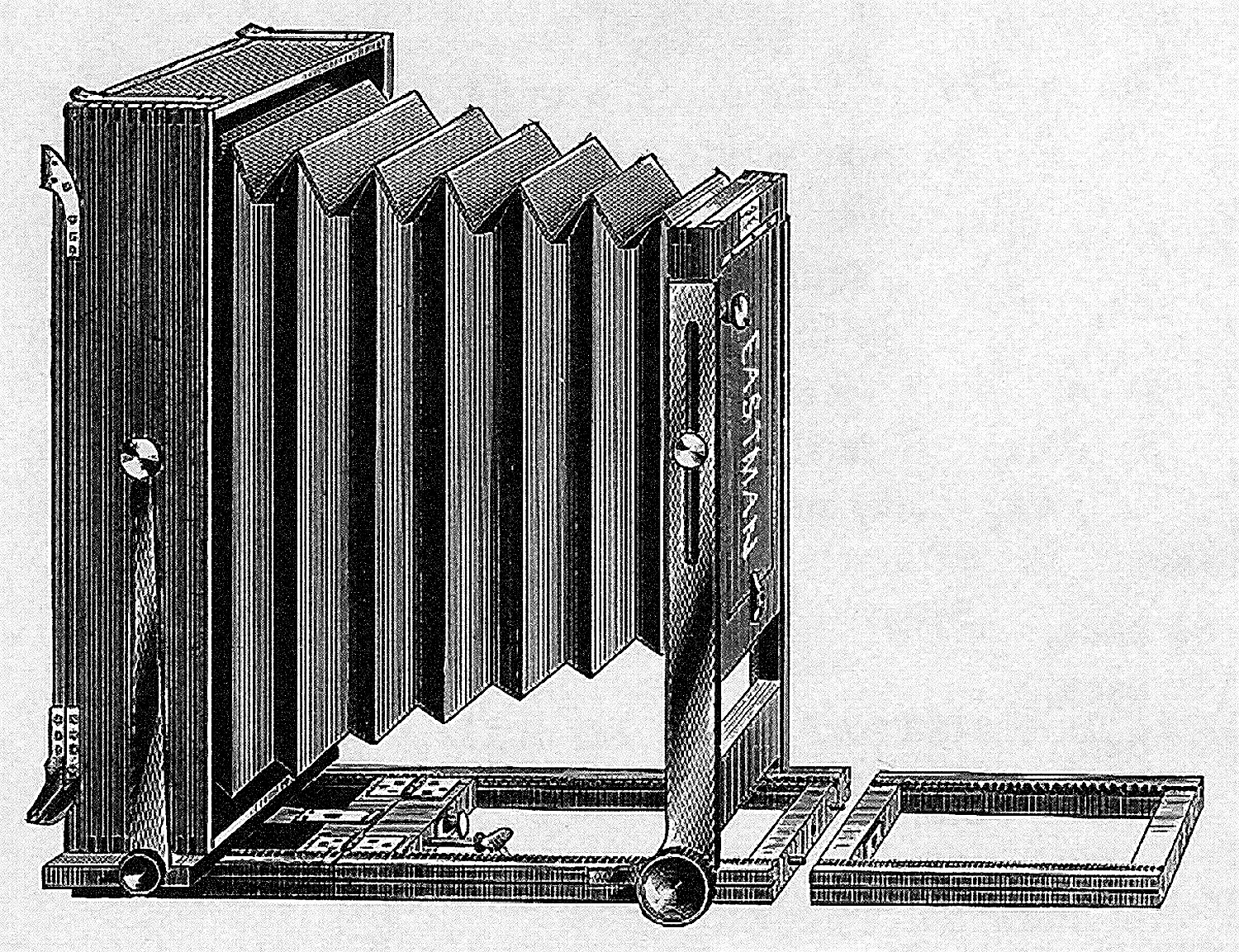
Interchangeable View Camera
No. 981, 5 x 8"
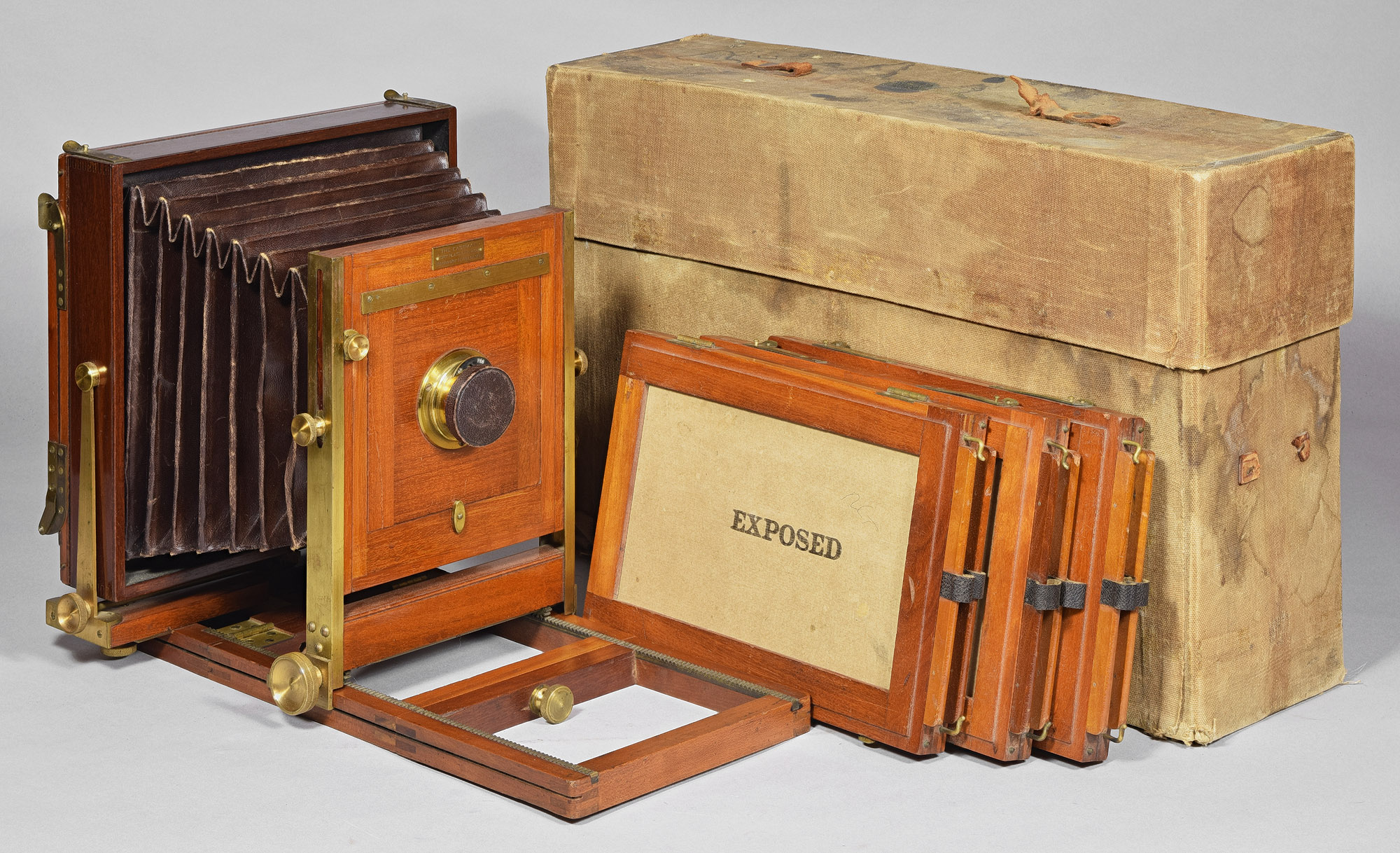
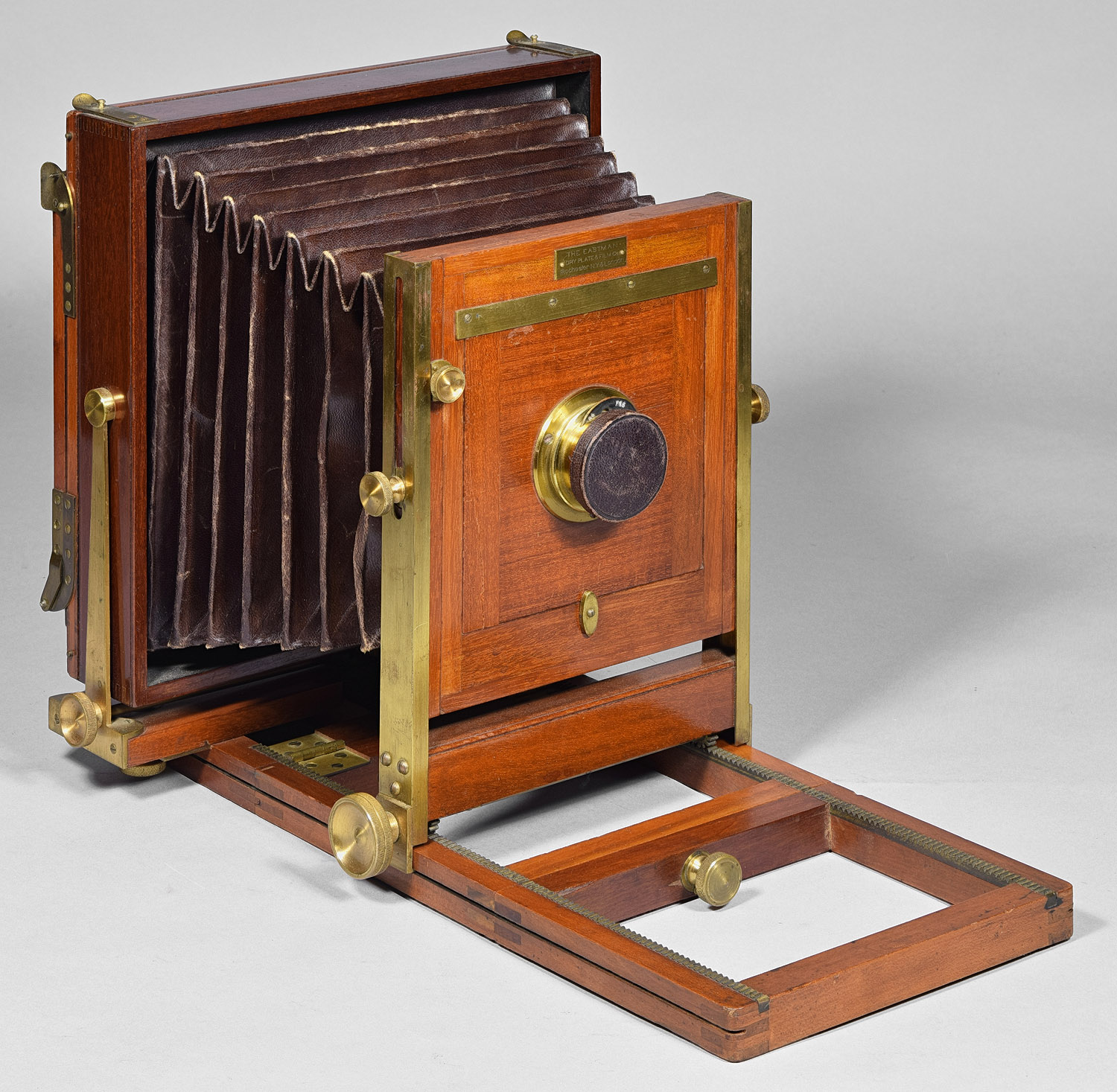
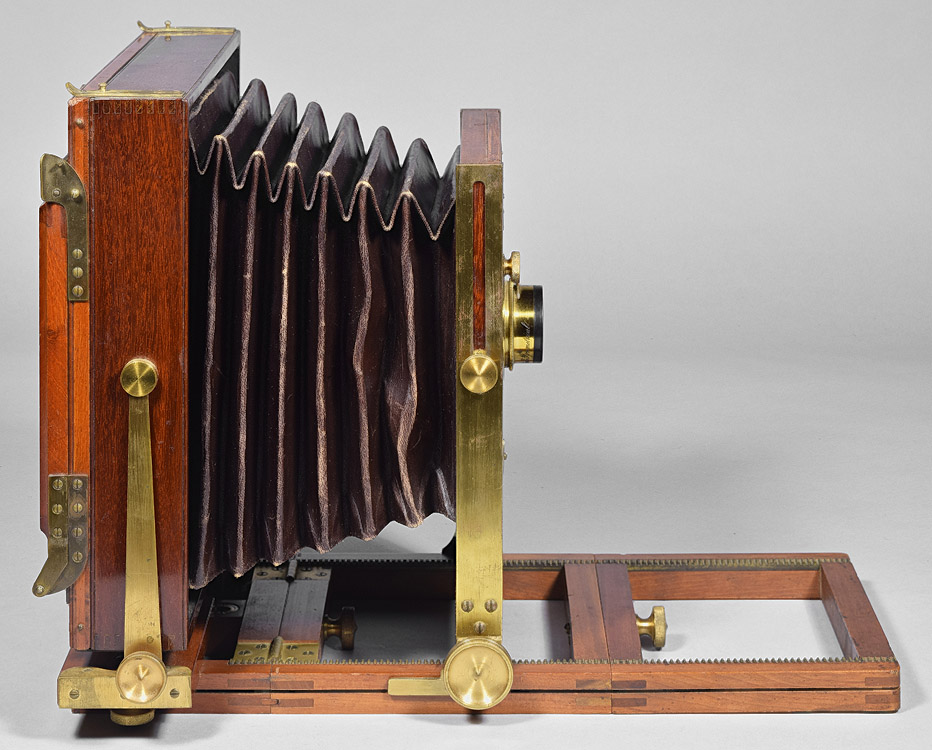
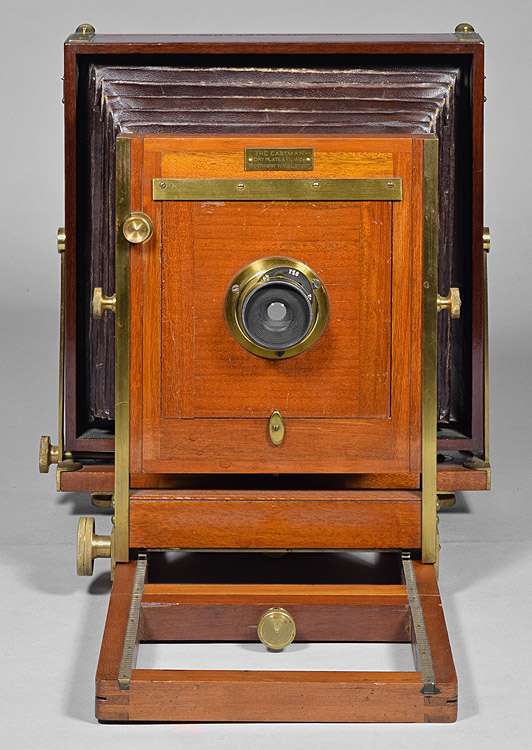
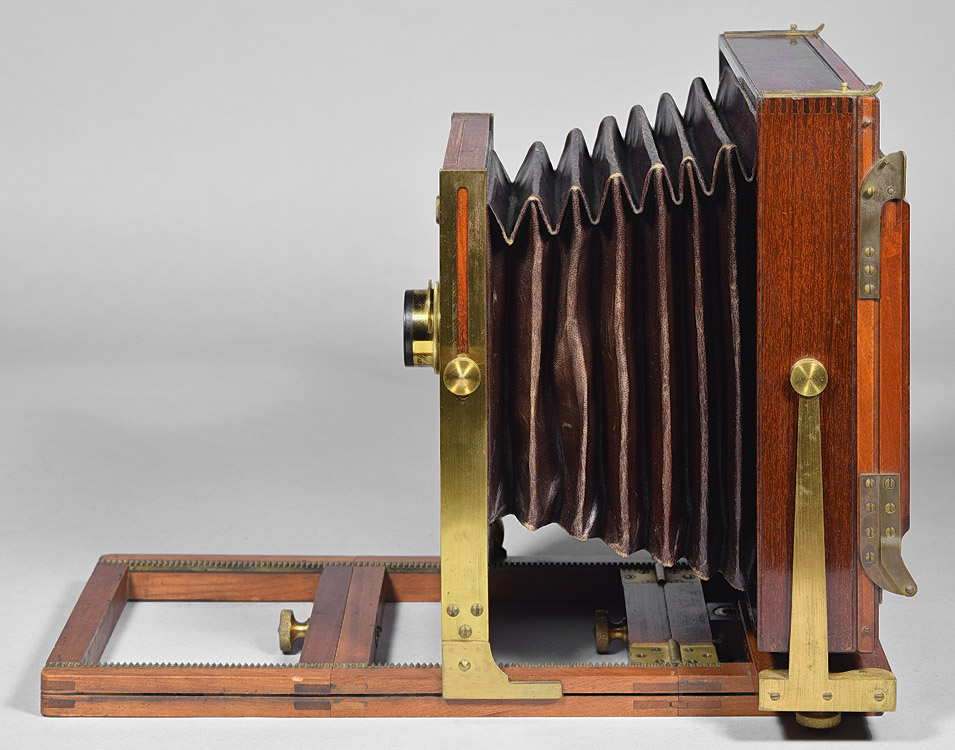
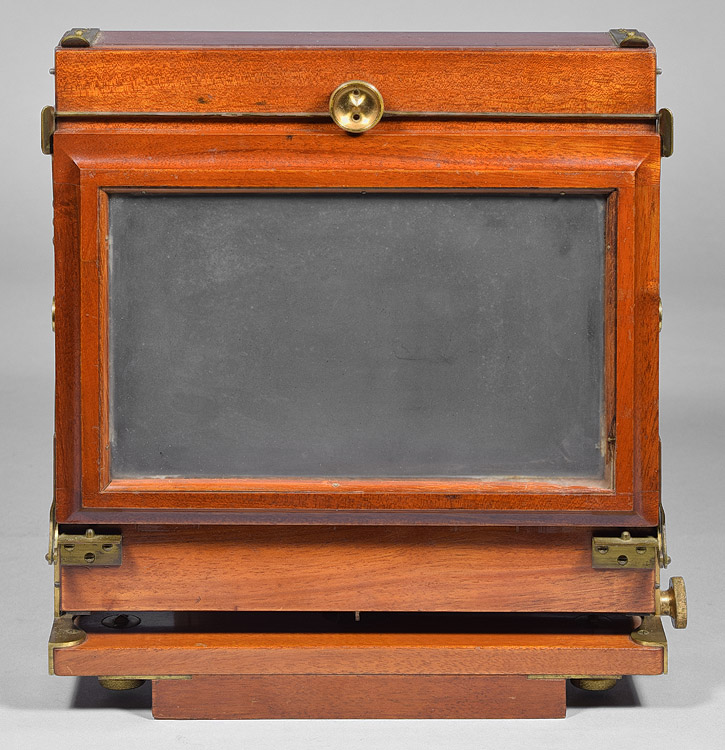
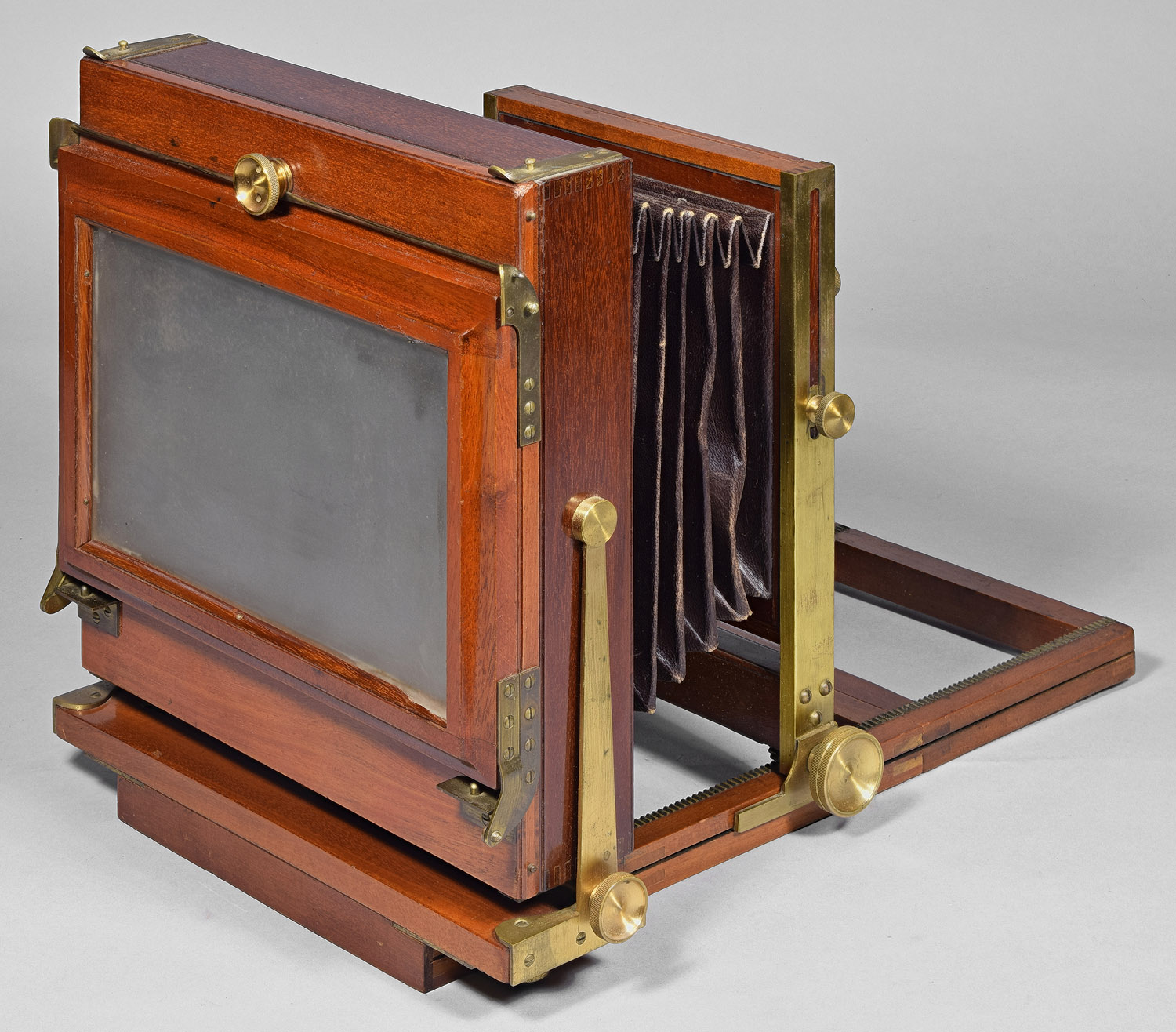
Ground glass frame down,
ready to accept a plate holder. The plate holder is held by the
two short rods on the bottom hardware and by the lever-like hardware at
the top, operated by the knob.
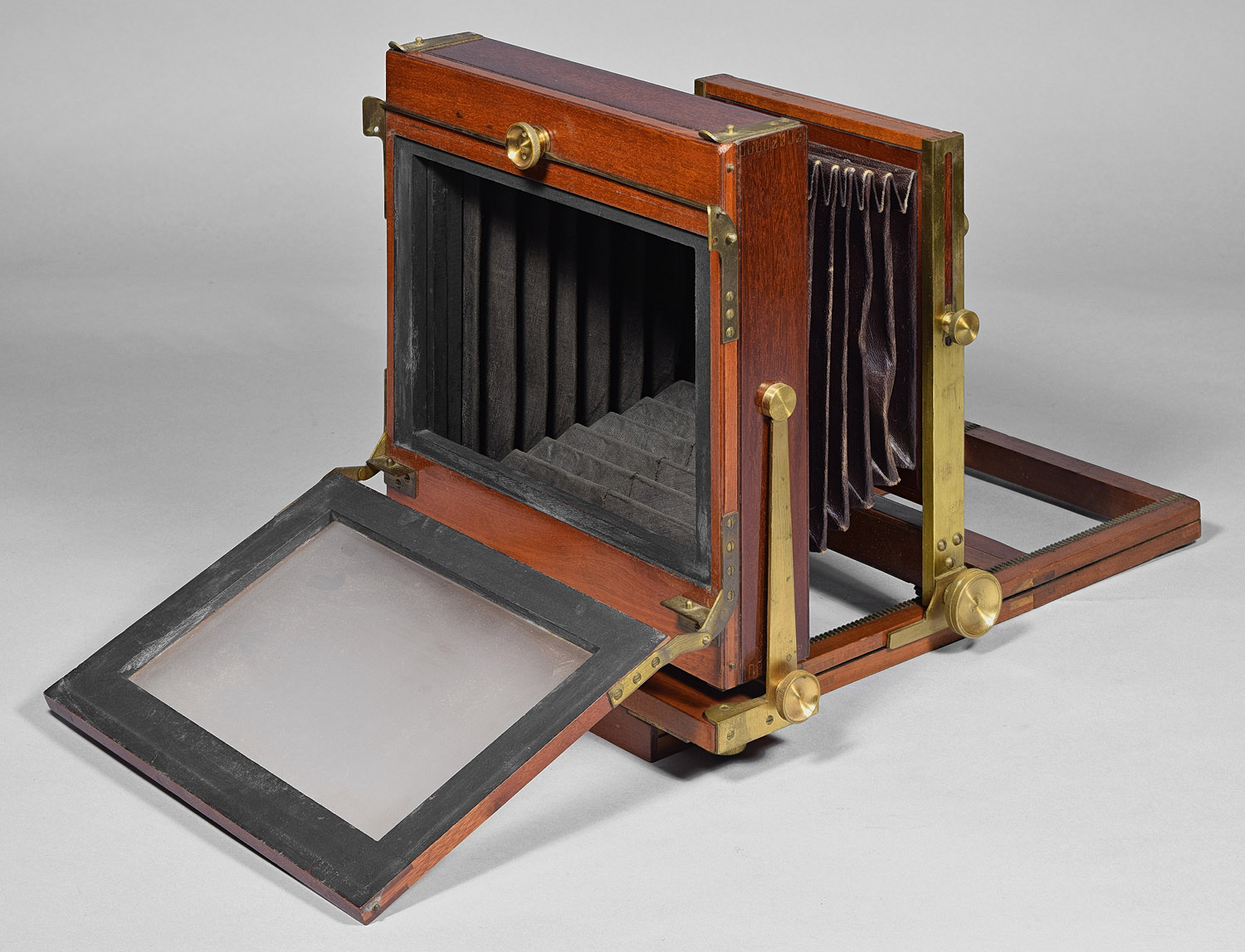
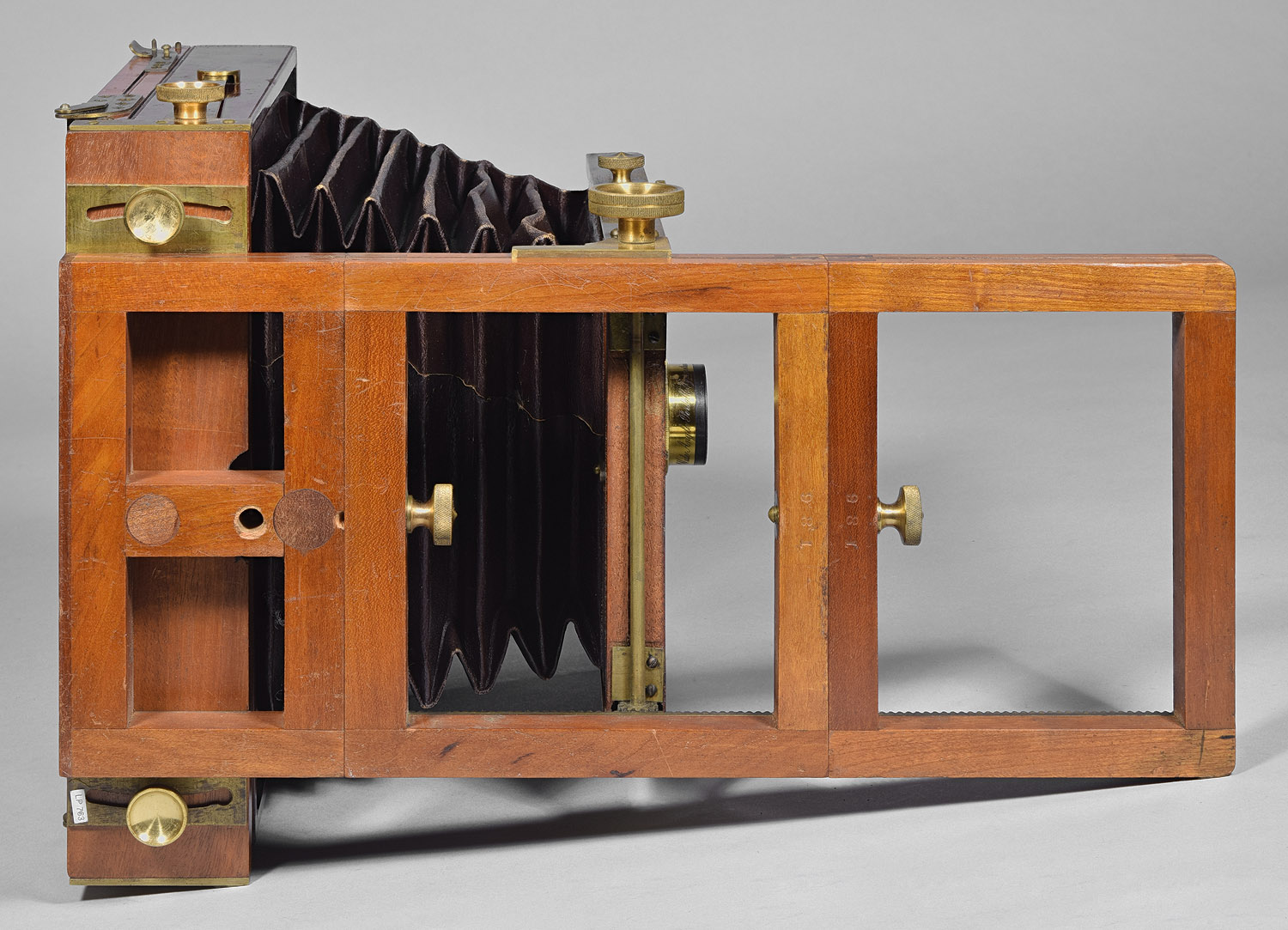
Label, brass, at the top
front of the front standard: "The Eastman Dry Plate & Film Co.,
Rochester, N.Y. & London".

Serial number (No. 981) on
the bottom of the main platform/bed, and also on the bottom of the front
extension.

Mechanism at the top of the
rear standard for engaging ground glass frame and plate holders.
When the knob is rotated counter-clockwise, the long rods push on the
outlying hardware ears, releasing corresponding rods located at the top
sides of the ground glass frame or plate holder.

The same mechanism seen from the side, showing a rod
on the ground glass frame seated in the corresponding hole in the
hardware ear.
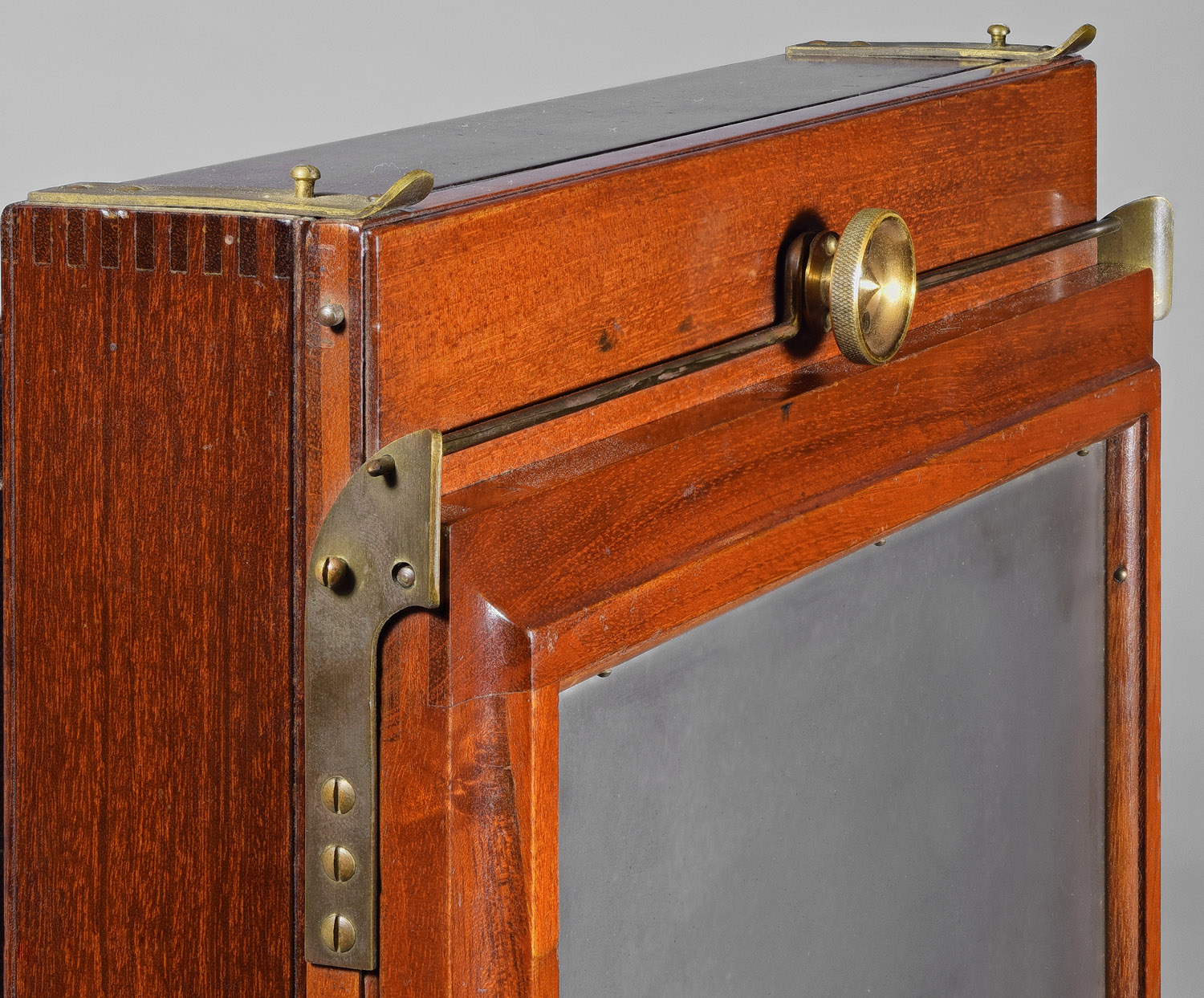
Plate holder that came with Variation 1
Interchangeable View

Variation 1 plate holder,
open.
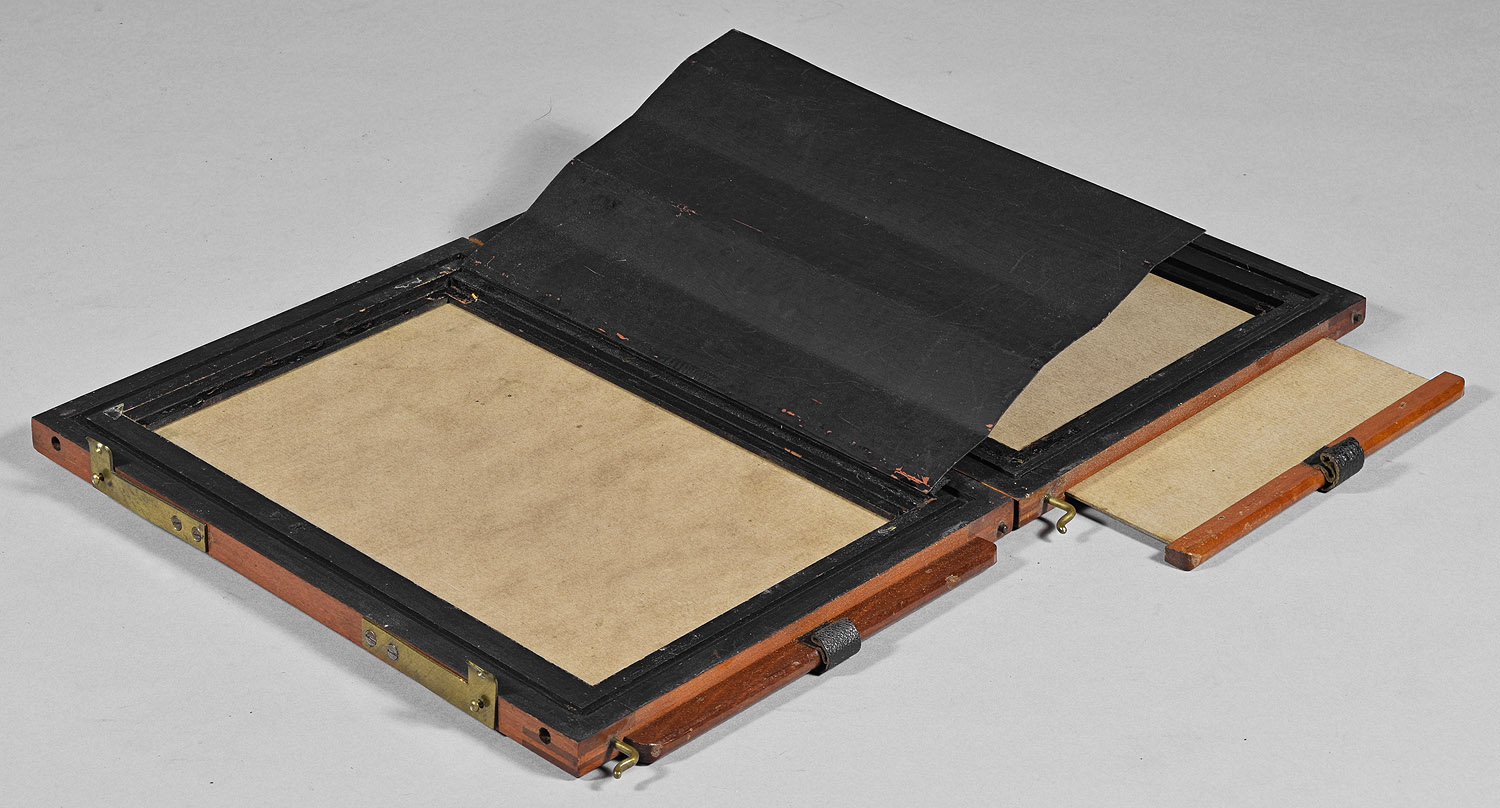
Date Introduced: - ;
Years Manufactured: c.1887 - c.1895
Construction: front focus
via rack and pinion (two gear tracks on top of base rails);
double swing; reversing by removable back; three-piece lens board
Materials: mahogany body; cherry base; red
leather bellows; brass hardware
Sizes Offered:
4 ½x5 ½; 4 ½x6 ½; 5x7; 5x8; 6 ½x8 ½; 8x10; 10x12; 11x14; 14x17;
17x20; 18x22; 20x24
Notes:
Eastman's Early Field View Cameras c.1887-c.1891:
In 2006, I had purchased a back focus, straight bellows view camera having an Eastman label. It came with a letter to the seller from Todd Gustavson, Technology Section, George Eastman House written to the former owner of the camera. In it Mr. Gustavson mentioned view cameras that had been produced in the early days of Eastman's companies. One was the Interchangeable View - I was already aware of, and already had at least one example, But there were two others of which I had never heard: 1) the Genesee View, known from short mention (no engravings) in 1887-1889 catalogs that I had not as yet seen (offered in 5x7 and 5x8 in 1887 and 1888, to which 6½x8½ was added in 1889), and 2) the Eureka View, only known from a copy of early production records typed in 1921 (which showed that it had been made in many sizes up to 18x22).
It was apparent that my camera purchase that started this information hunt was the Genesee View - a straight bellows camera in 18x22 size would be way too heavy to deal with in the field. I eventually purchased a second such camera in its original canvas case. These are shown on the Genesee View web page.
This left a problem: what is a Eureka View, and why is it not advertised along with the Genesee View or Interchangeable View? I kept looking for a distinctly different camera than the Interchageable View, but did not find any - only more Interchangeable Views, which I continued to buy because of their Swiss-watch-like construction and beautiful finish work. I had found that there were two variations of Eastman's Interchangeable View, one much rarer than the other (see table below). The difference between the variations is in the way the hinged back is released and in the way a plate holder is attached to the camera during use. The two variations would seem to have been considered by Eastman to both Interchangeable Views at the time, since catalog entries contain engravings of both variations in the same description (e.g., Gatchel, 1888, pp. 30-32). It would have been important for users to describe which variation they had, since plate holders that fit one would not fit the other. Despite never being advertised, it is surprising that, according to production records, there were 1372 Eureka Views made vs. only 404 Interchangeable Views (George Eastman's Cameras, Grant Haist, p.13).
So where are the Eureka Views and what do they look like?. Grant Haist, in his book The George Eastman Cameras, 2009, points out that the Interchangeable View could have two different backs (just as I had discovered on the cameras I examined), and that one of them was termed The Patented Eureka Ground Glass Adjustor, and suggests that the Eureka View is an Interchangeable View that has the Eureka back. I agree. Apparently, Eastman wanted to keep numbers of sales of both kinds of back, so referred in internal memos to Eureka cameras, but publically advertised both as Interchangeable Views, regardless of choice of back.
All of these Eastman view cameras were designed and their production supervised by Frank Brownell, a former cabinet maker, whose artistry really shows in the appearance and operation of the cameras.
The three early Eastman view cameras are:
Genesee View: This camera is a rear focus camera having a solid front and straight bellows, similar in design to the popular and common Scovill Waterbury View, or Anthony N.P.A. View of the time. It has a number of unique and very interesting features that distinguish it from its cheaper competition. 1) On top of the rear standard, there is a spring-loaded clip for securing the downward-hinged ground glass frame. 2) From afar, it has the ubiquitous slot down the middle of the platform that is used for push-pull focus, but no- the slot has concealed within it a toothed brass track for rack and pinion focus, controlled by a large knurled knob on the right. 3) The mechanism for front rise is also hidden, in this case, completely hidden except for the knob to lock it. 4) It plate holders have a groove or slot on their long edges, which slide into a corresponding recess in the camera back. This is similar to many cameras made in England, but rare in the United States. 5) The provision for changing to vertical format is also unique, utilizing a wooden panel that has two brass posts that fit into holes in the side of the front standard, and a hole with which to lock it. The wood extends the length of the camera for stability, and the rear standard merely slides as it is focused.
Interchangeable View General Design: Both variations of the Interchangeable View are the same except for their backs. The design is a front focus camera having a tapered bellows. The rear standard has double swing capability. Forward and back swing is via a central pivot that has a support that is a straight, tapering, stave-like piect of brass on each side, almost identical to those used in the Blair Camera Co. Reversible Back Improved Variation 3 and Variation 4., which are thought to have been made in the 1890's and so could have been based on the Eastman design. The front standard is supported by full length brass channels having a c-shaped cross-section. They are braced on their lower end by a block of mahogany, and on their upper end by the larger piece of mahogany in which the lens board is installed. The front standard has two types of rise; one in which the entire upper wood section of the front standard slides up or down within slots visible in the brass uprights of the standard, and a second rise that is locked by a knurled knob, which is in the conventional location of the upper right (as standing behind the camera) corner of the front standard. The mechanism for this rise is undoubtedly the same as for the Genesee View, which is also hidden. The focus is via rack and pinion, controlled by a large knurled knob on the lower right of the front standard. The tracks fore the rack and pinion are neatly inlet into the side rails of the platform. There is a short, removable, extension track for long focus lenses for the platform. As mentioned above, the two variations of the Interchangeable View were offered for sale at the same time, and the difference between the two variations is solely in the back. In either variation, the back is removable, being held by two spring clips at the top, so Eastman could make the fronts all the same, then clip on the appropriate back to order (as long as the back dimensions were standardized with sufficient precision). The wood used was high quality, and finely finished using the French polish method, in which much hand work with a rag charged with shellac leaves a thin but high gloss finish, at the same time filling the open grain of mahogany. The highest grades of other manufacturers wer also finished by the French polish method. The brass hardware is also finely finished using the draw file method, in which a file is used to produce a uniform scratches in one direction, then lacquered.
Interchangeable View Variation 1: This variation has a large thumbscrew in the top middle of its back attached to two horizontal rods. When the thumbscrew is turned counter-clockwise, it pushes the rods outwards, which pushes open spring-loaded latches at the sides of rear standard, releasing the ground glass frame to hinge downwards. This variation uses book-type plate holders having that install by matching holes in the lower edge of the plate holder to brass fittings at the bottom of the removable back, then snapping pins on the upper end of the plate holder into the spring-loaded latches at the upper part of the removable back (see Variation 1 photos).
Interchangeable View Variation 2 (Eureka View): This variation has no thumbscrew on its back as in Variation 1, but instead has L-shaped slotted hardware at the top of the rear standard that swivel to allow the ground glass frame to come out about ¾". From this position, two small spring-loaded latches located along the sides of the ground glass frame may bee pressed to release the hinged frame. Variation 2 cameras have a different style of plate holders than Variation 1. Variation 2 cameras have, on the back of the rear standard, top and bottom projections that fit corresponding grooves in Variation 2 plate holders that secures them like a tongue & groove joint. Variation 2 plate holders are loaded or unloaded from the front by moving a sliding switch to retract or extend a catch that secures the plates. This type of plate holder is also required for the Genesee View.
Variation 1 appears in earlier catalogs than Variation 2 (the reason why 1 is called 1 and 2 is called 2). The only question remaining about this chronology is that the example of Variation 1 has serial number 981, whereas examples of Variation 2 sometimes have lower serial numbers. As stated in the catalogs, either back could be installed, so that examples of Variation 1 and Variation 2 can be expected to have intermixed serial numbers.
Patent Drawings for the Eureka Back.

Interchangeable View Camera
Variation and Identification Details by Serial Number:
Whereas wooden view camera
usually have assembly numbers, that is low integers used in an era where
parts of a camera are nearly buy not exactly interchangeable. A
few manufacturers placed true serial numbers, that is, a number unique
to one camera, on their products. The Interchangeable View Camera
produced by the Eastman Dry Plate & Film Co. or The Eastman Co. from
1884-c.1891. In addition, I have owned a lot of these cameras,
owing to their being manufactured to tolerances akin to those of a Swiss
watch. Therefore, if the serial numbers are assumed to represent a
timeline of camera production, we have a chance to plot the
characteristics of the models over time.
| Serial No. (Accession Number) Location of Serial No. |
Variation | Size | Label Material | Manufacturer | Label Location |
| 304 (LP1253) Bottom of Platform |
2 (Eureka View) | 4¼x5½ | brass | Eastman Dry Plate & Film Co., Rochester, N.Y. & London | Lower Front Standard |
| 523 (LP478) Inside Ground Glass Frame |
2 (Eureka View) | 5x8 | brass | Eastman Dry Plate & Film Co., Rochester, N.Y. & London | Upper Front Standard |
| 700 (LP1275) Bottom of Platform |
2 (Eureka View) | 6½x8½ | celluloid | The Eastman Co. | Upper Front Standard |
| 748 (LP1286) Bottom of Platform |
2 (Eureka View) | 4¼x5½ | brass | Eastman Dry Plate & Film Co., Rochester, N.Y. & London | Lower Front Standard |
| 981 (LP763) Bottom of Platform |
1 (Original Interchangeable View | 5x8 | brass | Eastman Dry Plate & Film Co., Rochester, N.Y. & London | Upper Front Standard |
| 1256 (LP152) Bottom of Platform |
2 (Eureka View) | 5x7 | brass | Eastman Dry Plate & Film Co., Rochester, N.Y. & London | Upper Front Standard |
| 1608 (LP043) Bottom of Platform |
2 (Eureka View) | 6½x8½ | celluloid | The Eastman Co. | Upper Front Standard |
| 1645 (LP172) Bottom of Platform |
2 (Eureka View) | 8x10 | celluloid | The Eastman Co. | Upper Front Standard |
| 1664 (LP1285) Bottom of Platform |
2 (Eureka View) | 5x8 | brass | Eastman Dry Plate & Film Co., Rochester, N.Y. & London | Upper Front Standard |
Conclusions from table:
Variation: There is only one example of the Interchangeable View Variation 1, and it is in the middle (No. 981) of the range of serial numbers. This is not surprising, since the catalogs advertised that the Interchangeable View could be had either with or without the Eureka Ground Glass Adjuster, which feature is the only difference between Variation 1 and Variation 2 (The Eureka Camera).
Manufacturer: Most cameras were made by the Eastman Dry Plate & Film Co. (Eastman D.P.&F.), which makes sense. During the ~7 year production run, ~4 years were under that company, while ~3 years were under The Eastman Co. However, the earliest Eastman Co. is No. 700, while Eastman D.P.&F. labels are found even on the highest serial number of No. 1664. This is mystery if the serial numbers represent a chronological series.
Label Material: The presumably later Eastman Co. labels are all celluloid while the presumably earlier Eastman D.P.&F. labels are all brass. This does make sense. A consistent trend in camera manufacturing over time is that as a model changes over time, less expensive materials, like molded celluloid, are subsituted for more expensive materials, like engraved brass. For this camera, which is extremely well made and finished, the savings would have been infinitesimal, but it was done none the less.
Label Location: Only one size of camera, 4¼x5½", has the label on the lowest part of the front standard instead of the upper part. In this small size of camera, there just isn't enough room to locate the label on the upper part, which was clearly the preferred location, being used for the four other sizes.
References:
Photographic Lenses and How to Select Them, James W. Queen & Co.
(Philadelphia, PA), 1887, p. 33 (as Eastman's New View Camera)
Photographic Materials and Apparatus, Eastman
Dry Plate & Film Co. (Rochester, NY) Catalog, January 1888, p. 2-7
An
Illustrated Catalogue of Photographic Cameras, Lenses and Other
Apparatus and Materials for Photography, W.H. Walmsley & Co.
(Philadelphia, PA), April 1, 1888, p.10
The International Annual of Anthony's Photographic Bulletin,
Vol. I, 1888, W. J. Harrison and A. H.
Elliot, eds., E. & H. T. Anthony & Co. (New York, NY), July 1888, ads p.
27; 84
Catalogue Illustrated, W.D. Gatchel
(St. Louis) Catalog, 1888, p. 30-32
American Annual of Photography and Photographic Times Almanac for
1890, The Scovill & Adams Co. (New York, NY),
ads p. 48
Photographic Material,
Catalogue O & P, James W. Queen & Co. (Philadelphia,
PA), 1891, pp. 47-48
